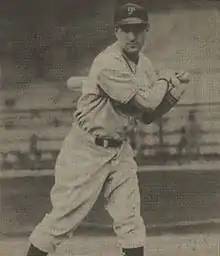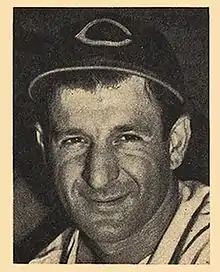Morrie Arnovich
Morris Arnovich (November 16, 1910 – July 20, 1959) nicknamed "Snooker", was an American baseball player. Arnovich played in the Major League Baseball between 1936 and 1946 and played in the World Series winning team in 1940 as a part of the Cincinnati Reds. Playing as an outfielder and line drive hitter he began in the MLB for the Philadelphia Phillies in 1936 where he played four seasons before joining the Reds for a season. After his time in Cincinnati, he joined the New York Giants for the 1941 season, and again for one game in 1946 after joining the United States Army.
| Morrie Arnovich | |||
|---|---|---|---|
 | |||
| Left fielder | |||
| Born: November 16, 1910 Superior, Wisconsin | |||
| Died: July 20, 1959 (aged 48) Superior, Wisconsin | |||
| |||
| MLB debut | |||
| September 14, 1936, for the Philadelphia Phillies | |||
| Last MLB appearance | |||
| April 21, 1946, for the New York Giants | |||
| MLB statistics | |||
| Batting average | .287 | ||
| Home runs | 22 | ||
| Runs batted in | 261 | ||
| Teams | |||
| |||
| Career highlights and awards | |||
| |||
A member of the National League All-Star team, he finished his career with a .287 batting average. After retiring, Arnovich coached basketball and died in 1959 of a coronary occlusion.
Early and personal life
Arnovich was born in Superior, Wisconsin on November 16, 1910.[1] One of the most religious Jewish major leaguers, Arnovich kept kosher his whole life.[2] He attended Superior High School in Superior, Wisconsin.[1] Arnovich was a two-time All-Wisconsin basketball star at the University of Wisconsin–Superior.[3] He was later given the nickname "snooker", after being prolific in the British game of the same name.[2][4][5]
Baseball career
Arnovich's professional baseball career began at age 22 with the Superior Blues, the champions of the newly revived Northern League in 1933.[2] Playing as a shortstop that year, he hit .331 and had a slugging percentage of .495 with 17 steals. Throughout the season he hit 14 home runs, putting him fourth in the league.[2] His .918 fielding percentage was best of any shortstop with 50 or more games that season and made the unofficial All-Star team listed by the Spalding Guide.[6] Returning to Superior in 1934, Arnovich hit .374 to take the Northern League batting title, and his 21 home runs (three in one game) tied for fifth.[2]
The Philadelphia Phillies purchased his contract in 1935, and assigned him to the Hazleton Mountaineers of the New York–Pennsylvania League where he hit .305.[2] In 1936, he hit .327 with 19 home runs and 109 runs batted in (RBI). He tied for the league lead in home runs and was one RBI from the best in the league. He played his first matches in Major League Baseball, where he made .313 over a few games. He moved to the outfield, playing mostly in left field for the rest of his career.[7]
In 1937, he hit .290 and had a career-high five double plays from the outfield.[7] In 1938, he made the most outfield assists of his career - 18 - a third of all outfielders in the league.[7] He also led all Northern League left fielders in double plays, with five, and in range factor/game, at 2.58.[1] He was referred to as the "Son of Israel", or the "Next Jewish Star".[8]
When Phil Weintraub entered the armed forces, Arnovich took his spot in the Phillies lineup.[9] For the 1939 season he was the top contact hitter in the National League before fading late and finishing fifth in the league with a .324 batting average, and sixth in the league with a .397 on base percentage.[8][1] He also led all Northern League left fielders in putouts, with 314, and in range factor/game, at 2.47.[1] He made the Nothern League All-Star team in his best season, 18th in the MVP voting.[1]

At the age of 29, Arnovich was traded to the Cincinnati Reds for Johnny Rizzo in June 1940 and had a disappointing season, though he continued to hit for solid contact (.284); he failed to homer and his lack of power was not good for an outfielder. He made his only World Series appearance that season. He was sold to the New York Giants in December 1940, and had a .280 batting average in 85 games.
Arnovich tried to volunteer for the United States Army, but was turned down because he was missing a pair of molars. He got false teeth and volunteered again after Pearl Harbor; this time he was permitted in and spent the next four years in the Army. He was a Staff Sergeant for the Army in the Pacific Theater of Operations.[3] While in the Army, Arnovich played for and managed the Fort Lewis baseball team, before becoming a postal clerk in New Guinea.[2]
Out of condition and now 35 years old, Morrie played in one game for the New York Giants in 1946 and was sent down to the Jersey City Giants, where he went 5 for 25 in 10 games before being released in June 1946. In 1947 Arnovich hit in the .370s in the Three-I League and Western Association, then batted .353 in limited time in the 1948 Southeastern League before retiring at the age of 37. In 2010 he was ranked ninth in career batting average among Jewish major league baseball players of all-time.[10]
Career statistics
In 590 games over seven seasons, Arnovich posted a .287 batting average (577-for-2013) with 234 runs, 104 doubles, 12 triples, 22 home runs, 261 RBI, 17 stolen bases, 185 bases on balls, .350 on-base percentage and .383 slugging percentage.[1][2][11] Defensively, he recorded a .981 fielding percentage playing primarily at left field, but played several games at center and right field.[1][12]
Later years and death
Arnovich coached basketball for a Catholic high school in Superior after retiring, then ran a jewelry store and a sporting goods store.[2] It was reported in the Superior Evening Telegram in 1949 that Arnovich, who had managed in the Cubs minor league organization, had signed on as a referee in the new National Basketball Association.[2] He married Bertha Aserson on July 10, 1956 and ran a jewellery and sporting goods shop.[2] On July 20, 1959, he died of a coronary occlusion at his home shortly after his third wedding anniversary. Arnovich is buried in the Hebrew Cemetery in Superior, Wisconsin.[2][13]
References
- "Morrie Arnovich Stats | Baseball-Reference.com". Archived from the original on 2018-03-29. Retrieved 2018-03-26.
- Berger, Ralph. "Morrie Arnovich". SABR. Archived from the original on 2007-12-25. Retrieved 2008-01-27.
- "Baseball in Wartime - Morrie Arnovich". Archived from the original on 2016-03-08. Retrieved 2018-03-28.
- James, Bill (2010-05-11). The New Bill James Historical Baseball Abstract. ISBN 9781439106938. Retrieved February 16, 2011.
- "Pete McEntegart: A walking Encyclopedia". Sports Illustrated. June 9, 2004. Archived from the original on June 28, 2011. Retrieved February 16, 2011.
- Spaldings official base ball guide. 45 Rose Street, New York: American Sports Publishing Company.CS1 maint: location (link)
- "Morrie Arnovich Statistics and History". Baseball-Reference.com. Archived from the original on January 26, 2011. Retrieved February 16, 2011.
- Levine, Peter (1993-09-09). Ellis Island to Ebbets Field: Sport and the American Jewish Experience. ISBN 9780195359008. Archived from the original on 2021-01-25. Retrieved February 16, 2011.
- The Big Book of Jewish Sports Heroes: An Illustrated Compendium of Sports History and The 150 Greatest Jewish Sports Stars. SP Books. 2007. ISBN 9781561719075. Archived from the original on January 25, 2021. Retrieved February 16, 2011.
- "Career Batting Leaders through 2010". Career Leaders. Jewish Major Leaguers. Archived from the original on April 17, 2019. Retrieved February 10, 2011.
- Ribalow, Harold Uriel; Ribalow, Meir Z. (1984). Jewish Baseball Stars. ISBN 9780882548982. Retrieved 25 January 2021.
- Horvitz, Peter S.; Horvitz, Joachim (2001). The Big Book of Jewish Baseball. ISBN 9781561719730. Retrieved 25 January 2021.
- "MORRIE ARNOVICH (Published 1959)". nytimes.com. July 1, 1959. Retrieved 25 January 2021.
External links
- Career statistics and player information from Baseball-Reference, or Fangraphs
- Morrie Arnovich at B-R Bullpen